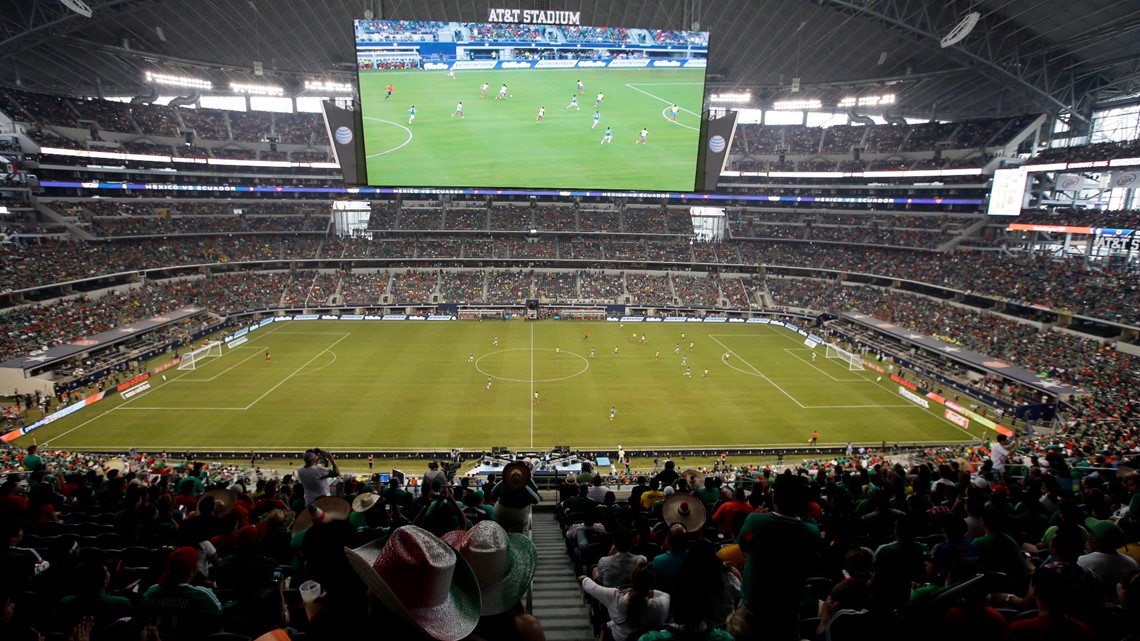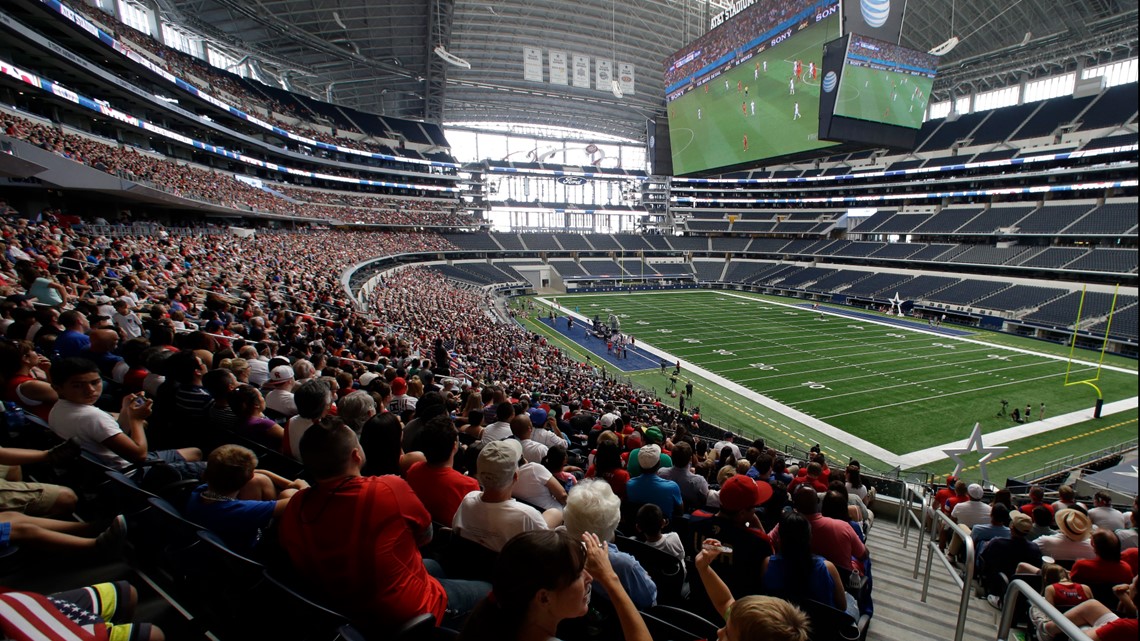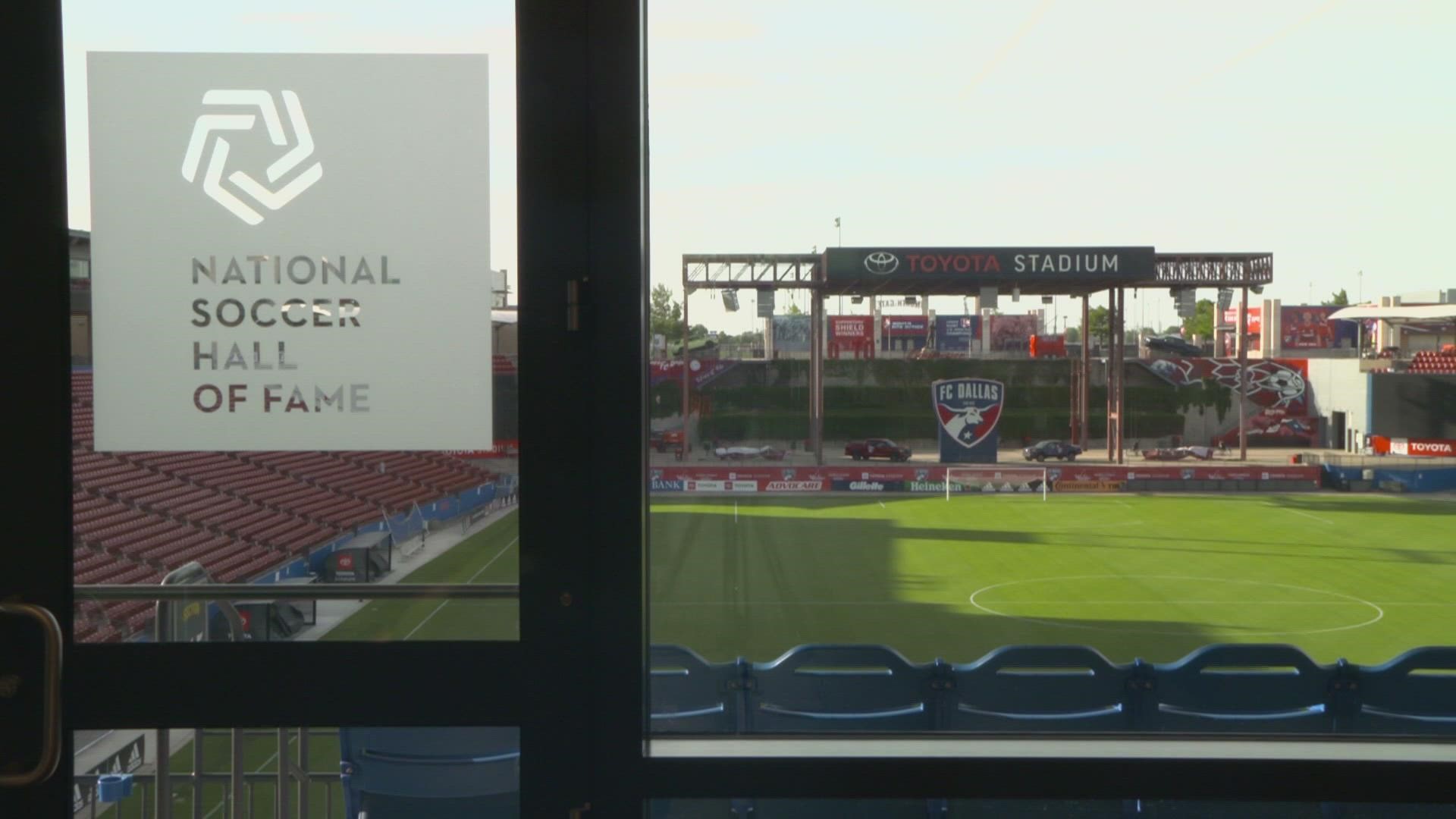DALLAS — On June 16, FIFA will announce the host cities for the 2026 World Cup, set to be played in the United States, Canada and Mexico.
The 2026 World Cup will be the first with three co-hosts. FIFA selected the bid as joint host in June 2018. Sixty games are to be played in the U.S., including all from the quarterfinals on. Canada and Mexico are to host 10 games each.
Among the remaining 17 U.S. stadiums in 16 areas vying for a bid: AT&T Stadium – a.k.a "Jerry World" – in Arlington.
But will Dallas get selected as a host city? FC Dallas president Dan Hunt and head coach Nico Estévez discussed Dallas’ shot at hosting the FIFA World Cup games on June 15, one day before the host site announcement.
Monica Paul with the Dallas Sports Commission told WFAA's William Joy that a bid granted for DFW would could create 3,000 jobs with a $400 million impact.
The Associated Press reported that the 1994 Cup drew a record 3.59 million fans and grossed $580 million, which produced a profit of $133.25 million for FIFA and $50 million for the U.S. organizing committee. FIFA said the 2018 World Cup in Russia produced $5.357 billion in revenue over the four-year cycle and a $3.533 billion surplus.
Hunt, Estévez and others leaders in the Dallas Bid Committee have put together their pitch for DFW to be an integral part of the 2026 World Cup experience, which can be viewed online here:
Venues and training facilities
AT&T Stadium serves as Dallas' marquee venue for a World Cup bid, with a capacity of 92,300 for World Cup matches. Hunt told WFAA they hope Dallas is chosen for the World Cup final or a semifinal, but those decisions won't come until likely early 2023 after the 2022 World Cup concludes in Qatar.
AT&T Stadium has become a mainstay for Mexican national team matches in the past few years, as well as world-famous clubs Chelsea, Barcelona and Club America.


But the facility space goes far beyond Jerry World.
The Dallas Bid Committee highlighted numerous spots and venues in the area that would serve as great facilities for not only games but training facilities, including the Cotton Bowl in Fair Park, Toyota Stadium in Frisco, MoneyGram Soccer Park in Dallas, Westcott Field at Southern Methodist University, Patriot Soccer Field at Dallas Baptist University, University of Texas at Dallas soccer complex and Rail Road Park in Lewisville.
When the World Cup came to the US in 1994, the Cotton Bowl hosted six games, including a memorable quarterfinal match between the Netherlands and Brazil, remembered as arguably the entire tournament’s top match. It was also recently announced that the Cotton Bowl would host FC Barcelona and Juventus in a late-July match.
The Dallas Bid Committee also points to Fair Park as a premiere location for media and broadcast operations, as well as fan fest and entertainment. Other DFW-area venues the committee highlights in its pitch include: Sundance Square in Fort Worth, Arlington Entertainment District and Klyde Warren Park.
Location, travel capabilities
Aside from the ample venues, the Dallas Bid Committee puts emphasis on the region's centralized geographical location compared to other potential World Cup sites, as well as the areas two airports. The committee says the two airports allow athletes, coaches, attendees and others to get in and out of Dallas easily, while being able to fly to most other sites.
“They can hop on a plane at a major airport or a private airport and very quickly to get to any spot in the bid,” Hunt told the Sports Business Journal. “They can even be in Canada in three-and-a-half hours.”
Sports Business Journal reported that DFW sees nearly 200,000 passengers each day, utilizing 22 different airlines from 258 destinations.
“The World Cup surpasses even the Super Bowl, but we’re the fourth-largest metropolitan area in the country, and we’ve got one of the busiest and largest airports in the world,” said John Ackerman, executive vice president, Global Strategy and Development, DFW Airport. “We’re well-versed in hosting large groups like this. We know how to handle the VIPs, and we know how to handle just the sheer volume of fans.”
Dallas' soccer history: A passion for the world's game
This part is multifaceted. You can start with the fact that one of soccer's founding fathers in America, Lamar Hunt, went to college at SMU and lived in Dallas. Hunt was one of the original investors in Major League Soccer (MLS), owning two teams: the Columbus Crew and the Kansas City Wizards (now Sporting Kansas City). In 2003, Hunt purchased a third team, the Dallas Burn (now FC Dallas). Lamar Hunt died December 13, 2006, at Presbyterian Hospital in Dallas of complications related to prostate cancer. The U.S. Open Cup, which dates back to 1913, was renamed the Lamar Hunt U.S. Open Cup in 1999.
The National Soccer Hall of Fame is in Frisco in the south end of FC Dallas' Toyota Stadium. Throughout the museum, there are hundreds of pieces of soccer memorabilia, including FIFA Women’s World Cup trophies, championship jerseys, and a Hall of Fame inductees wall. USMNT legend and East Texas native Clint Dempsey was inducted this year.
The soccer culture is deeply-rooted in North Texas, from the big leagues to the kiddos. Dallas is home to the second largest youth soccer organization in the country, according to the bid committee. The DFW area is home to many youth soccer tournaments and other events that typically draw hundreds of teams and thousands of young athletes and their families, most notably the Dallas Cup.
The list of distinguished alumni of the Dallas Cup includes (but is not limited to): David Beckham, Clint Dempsey, Chicharito, Landon Donovan, Raul, Andrea Pirlo, Michael Bradley, Wayne Rooney, Alphonso Davies, Bukayo Saka, Weston McKennie, and Mason Greenwood. In fact, Dallas Cup alumni have gone on to play in over 500 World Cup matches, according to the event's website.
Looking forward to 2026
Paul told WFAA the bid could also mean improvements at Fair Park if Dallas gets the International Broadcast Center it’s hoping for and better public transit to AT&T Stadium.
"Hope that we’re all celebrating [on June 16] and get ready to then start the real work of actually planning a World Cup,” Paul said.
Whether or not Dallas is chosen, the interest in the World Cup here in Texas will be sky high. AT&T Stadium served as a host site for watch parties during the 2014 World Cup run.


All eyes were on the World Cup here in Texas, and the numbers prove it. Austin, Texas, was the top U.S. market during the Women's World Cup in 2019, per Nielsen Market Research numbers. The interest in the Lone Star State is there. The opportunity to host just needs to be granted. We'll find out on Thursday, June 16.
Stay tuned.
The Associated Press contributed to this report.

